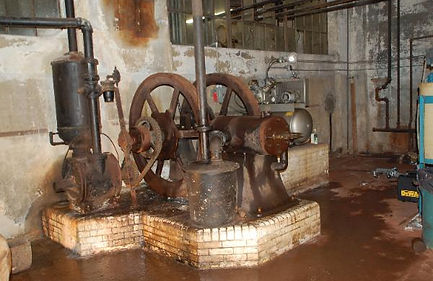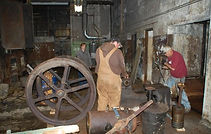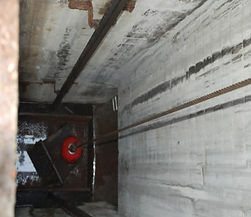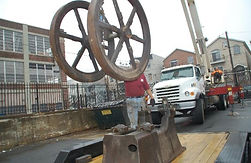Backus
















































The Backus Story
As seen in the June/July 2023 Gas Engine Magazine

Michigan Family Retrieves Backus Engine from Basement
Author recounts rehoming and restoring 14hp engine from four stories underground.
By Ed Laginess
Images by Karen Laginess
The Backus sits in Ed’s small museum in Carleton, Michigan.
March 2015 is a month I will never forget. This was by far the most fun several of my family members and I have ever had acquiring a gas engine. I was offered the opportunity to purchase a gas engine, however, we had to get it out of a basement that was four stories underground. The Backus flywheels sit higher than any of the other engines in the barn.
The adventure begins
In the beginning of March, I received an email in regards to an engine for sale. According to the email there were no identifying marks on the engine, they just wanted it gone. When looking at the photos of the engine in the email, I was pretty sure it was a rare old-style Backus. The engine sat on a white ceramic tile base in a dingy dark room. Engines like this don’t turn up every day. My first thought was, who is playing a joke on me? It seemed too good to be true. Skeptically, I called the number and spoke with a gentleman named Tim from World Impact Ministries located in Newark, New Jersey. Tim was in charge at World Impact and told me he was a car collector and knew a little bit about old items and their value. He thought the engine in the basement of their building was a steam engine. Tim and his crew did not want to see this neat piece of history get scrapped. They knew someone would want it, so they contacted me. They wanted to sell, but I would be responsible for getting the engine out of the building’s basement. I was super interested but still doubtful. I had some questions that Tim could not answer right away. He said he would get back with me. Several days went by and I didn’t hear back from him. My wife, Karen, insisted I call him back. I made the call and received the answers I needed. I couldn’t believe it. This was a legitimate deal. My excitement level went through the roof. Tim had a scrapper come in months earlier to give him a quote and details of how they would remove the engine from the basement. Tim forwarded all this information to me thinking it would be helpful. The scrapper’s quote had photos of the building, the steps, the corners, and the doors the engine would have to be hauled through, up, around, and out to get the engine to ground level. After several phone calls back and forth with questions about the building and specifics on the engine, Tim mentioned all the brass was stolen when the building sat empty in the 1990s. With no identification, I wasn’t sure what size the engine was. With Tim’s measurements and my research, I was pretty sure it was a 12 to 14hp old-style Backus.
Assembling a crew
I did not have a Backus so I was super excited and needed to work quickly. The plan was to pick the engine up the following week. I assembled my crew: Karen, my oldest son, Eddy, and our youngest son, Ryan. Eddy just happened to be starting spring break from college that week and we took Ryan out of high school for a few days. It was an excellent learning experience. Our daughters, Holly and Amber, were in college and were unable to get time off.
Making a plan
Now for the planning to remove the engine. How was I going to get this engine out of the building safely? Even with the scrapper’s information, there were still a lot of logistics to figure out. Safety was important to me. I did not want anyone to get hurt. The one thing I knew for sure was the engine had to come apart and had to be taken out piece by piece. However, there were several long flights of stairs and twists and turns. How were we going to get the engine pieces up the steps? Again, safety was the most important thing. I made several more phone calls to Tim and finally had a plan together.
I sat in my chair, with my head spinning, making a list of tools I would need if something were to go wrong. I wanted everything in place for plans A, B, C, and D. I knew I would need a moveable gantry crane to lift and move the heavy parts. I needed dollies, which I’d just bought at a flea market the month before, to move the heavy parts around once we got them off. The plan was to have everything I needed so I would not have to go to a store in Newark. The next several days we were shopping for tools and things I did not have. Then, we loaded up the van and got the trailer ready to go.
Van, trailer, tools and supplies – check.
An unexpected complication
We were ready to go. Then, the morning before our adventure, Eddy came down with strep throat at college and was not sure he could drive home. With an early morning visit to quick care, medicine, and rest, he made it. I figured he wouldn’t miss this for anything. We headed out early the next morning – strategically to miss the Newark rush hour traffic – for the 10-hour drive. We arrived at World Impact at 2 p.m. in the afternoon.
Seeing the Backus for the first time
Once we got there, we had to be allowed into a gated parking lot behind the World Impact building. The neighborhood was not bad, but the surrounding areas weren’t the greatest. We met with Ron, an employee and a resident of the World Impact building. He gave us a remote for the entrance gate and a key to the building so we could get in and out without having to contact anyone. Then he took us down several long flights of stairs and through a hallway with white ceramic brick walls on one side and a concrete block wall with high windows at the top on the other side. When we reached the boiler area, there were several entrances. The door on the left was the room with the engine. We were all so excited to go into this room and see this engine. We were led through the door and there she sat, a beautifully preserved 14hp Backus engine, on its original site. The engine was sitting on a base made out of glazed white ceramic bricks. The grease can and brushes were still sitting next to the engine as if the mechanics just left yesterday. You could just imagine, back in the day, the white brick and the engine room being meticulous. The lights in the engine room did not work. The only light we had was coming through the high windows from the boiler room and hallway, but that was not enough. We used our flash lights, and Ron found some trouble lights for us. We made it work. We were told the building had flooded several time, and there were puddles and mud on the basement floors with some rooms containing more water than others. It was going to be a dirty job.
A bonus view of NYC
They offered us a place to stay on site during our time in Newark. The World Impact building was quite large. It covered a city block. In 2015, it was the home to several churches and a private school. World Impact did ministry work within the local community. At times they would have groups come in and stay while they did their ministry work. They offered us the bunk room these ministry groups used. The bunk room was an old classroom with a bunch of bunk beds and a lounge. They showed us the way to the bunk room, which was on the opposite side of the building and several floors up. As Ron was showing us the way back to the basement, he took a detour to the roof patio and showed us the view of downtown New York City where the Twin Towers used to be. It was really neat to see. After heading back to the van, we hauled all our sleeping bags, pillows, clothes, and towels to the bunk room before heading down to the basement to start our work.
Ready, set, go
When we finally returned to the basement, Ron made sure we had everything we needed before he left. We knew we had lots of work to do. Now the tools we brought to take apart the engine had to be hauled to the basement. Karen, Eddy, Ryan, and I made one trip, then Eddy, still not feeling well stayed in the basement with Karen setting up our lights and organizing the tools and supplies. Ryan and I hauled the rest of the crates of tools and supplies down four flights of stairs. Ryan and I assembled the gantry crane while Eddy and Karen began wrenching on the engine. Karen began with one of the cylinder head nuts and it moved easily. She said she knew we were not going to have any trouble taking this engine apart after that. Karen removed more than half of the nuts and bolts on the engine. Ed securing the cylinder to a dolly to get ready to move to the dumbwaiter area for removal. Everyone needed a break and it was dinner time, so we headed to a McDonalds a couple blocks away. We didn’t know the area and it was getting dark so we decided to take the van. Upon returning, curiosity got the better of us. We had to check out the rest of the basement. It was a huge square block building so there was a lot to investigate. There was a balcony in the room in which we were working, and we found a restroom and former offices up there. Many rooms were dark and empty. Some had remnants (cabinets, office furniture, toilets) of what the rooms were used for. The room on the other side of the boilers was a mechanics room of some sort. It had tool cabinets and work benches. This room lead to a large open room that you could tell once housed some sort of engine, possibly steam. The concrete floor had a hole where a large flywheel would have been. I’m sure these rooms were busy in the building’s heyday. Graffiti littered some of the walls, left when the building sat empty.
We returned to the boiler room, which was easy to find because it was the only room with working lights. The boilers were gigantic. They had several massive doors and one was on the ground. Eddy and Karen tried to move it with no success. We worked around it. You could just image how beautiful and clean these rooms were back in the day. The boilers were surrounded by white glazed brick walls and a keystone date plate that read 1921. Besides the Backus room, opposite from the boilers, there were three other rooms. One room was slightly flooded and full of cans, the other room was empty and the third was an old unusable dumb waiter. I knew that had to go somewhere. It definitely was not in working condition because it was a little flooded under the bottom plate. We did some searching and found the dumb waiter had a 40-foot shaft that led upward to two diamond plate doors opening to the ground level about 60 feet from the parking lot entrance. The doors were welded shut. We asked Ron if the doors could be unsealed and the engine taken out through the dumb waiter shaft. He checked on this for us and we were given a thumbs up. This changed everything. He gave us the name of a local crane operator. Now the plans have changed. No stairs, no turns, no doors, no hauling, and a much safer way to move the engine. All the parts would just fit, with inches to spare, in the dumb waiter shaft.
Breaking down the engine
It took us five hours to take apart the engine. At 10 p.m., we had all the large parts put on wheeled dollies and sitting by the dumb waiter. The engine was ready for removal the next morning. We were filthy and tired. We headed up to the bunk room to shower and sleep, saving our dirty clothes for the next day.
As I lay there, excited and planning out the next day, all I heard were sirens. We found out the building was near a hospital. We all live in the country and we were not accustomed to the city sounds or sirens all night. We all eventually fell asleep from sheer exhaustion.
Up and out
The next morning, we were up and ready to go. We put our dirty clothes back on so we didn’t ruin anymore. Ron, who lived on the same floor as the bunk room, offered us a bowl of cereal, toast and orange juice. I called the crane guy, and he said he wouldn’t be able to come for about a week. He inquired about the site and said that if he had to park on the street, we would need a permit. I told him I would pay cash if he could come that day and we thought he could park in the parking lot. We agreed on a price and he arrived about one hour later. While we waited, I cut the welds away from the dumb waiter doors at the ground level to get them to open. I wondered how many years it had been since they were last used. Now we had direct access to the basement where the engine parts waited 40 feet down.
The World Impact building still housed a working school. People would be going in and out of the entrance gate all day, and we were told not to block the entrance. We moved some dumpsters out of the way, and, with limited space, the crane guy maneuvered his rig just in the parking lot out of the way of the entrance gate. He asked who was rigging the engine parts and I said I was. He never even looked at what he was pulling out of this shaft hole in the ground.
The Backus flywheels in the air being brought over to the trailer to be put back on the engine base.
First, I rigged up the base, which the crane pulled out with ease. The next thing you know, it’s floating through the air heading for the trailer. From the basement, the boys and I had to run up four flights of stairs, down a hall, out around the dumb waiter shaft, and through the parking lot to the trailer. We backed it up so the crane operator could set the base on it. I had to move the van and trailer back and forth each time a part was removed from the shaft to keep the parking lot entrance lane clear. When lowering the base onto the trailer, Eddy, Ryan and I had to do some muscling as we guided the base down.
I moved the van back out of the way, Ryan and I went back down the four flights of stairs and rigged up the flywheels. I was a little nervous about the flywheels going out. It was going to be tight. Next thing you know the flywheels rolled into the dumbwaiter shaft with only 4 inches to spare on each side. They never bumped or hit the side walls. I ran back upstairs, backed the van up, and the crane operator set the flywheels on the engine base with precision as we guided them. This crane operator was good.
A street view looking down the dumbwaiter shaft at the flywheels.
I moved the van again, went downstairs several more times to rig the other parts, ran upstairs to move the van back, placing the parts on the engine and repeated the process.
-
Cylinder – check
-
Piston – check
-
Muffler – check
-
Gantry crane – check
We reassembled the base, flywheels and cylinder on the trailer as they came out.
Finishing up
We still had a lot of work to do. We had to haul the rest of the parts and tools out of the basement. With four us it went a little faster. We had to secure the parts on the engine and tie it down to the trailer. It had been sunny a good portion of the time the engine was being removed. It started to rain when we were almost done removing the last of the engine parts and continued as we secured the engine and packed up to go. It was amazing to think that this 14hp Backus was in this building close to 100 years. We were able to disassemble it in five hours, haul it out, and reassemble it on the trailer in less than 24 hours.
We headed to the bunk room to clean up and change clothes before the ride home. We hauled all of our belongings to the van. It was noon and we were ready to go. We conducted business with World Impact and they gave us a tour of the school and the building. We returned the keys and gate remote, thanked them for the opportunity to purchase and remove the engine, said our goodbyes, and headed out of Newark just prior to rush hour. It started snowing on our way home. We were all exhausted, so we decided to stop in Pennsylvania for the night and continue home the next day.
Back home
At home, the Backus sat on the trailer for a couple of days until the weather cleared up. Eddy and I unloaded and rebuilt the gantry crane we needed to unload the Backus. Karen made a photo book documenting our adventure for my birthday. What an incredible birthday and adventure it was. The 14hp Backus made the trek from a basement in Newark, New Jersey, to Carleton, Michigan.
The Backus sat for several days supported by the gantry crane as I built a wooden base for it. One evening Eddy, Karen, and I lowered the engine on the base. Now the engine can sit on its own again. It isn’t as pretty as the white ceramic tile, but it does the job. Over the next several months, I acquired needed parts and had a few made in order to complete the engine. A friend even had a reproduction brass tag for it.
The team making sure all the bolts are in and figuring out how to tie it down to secure it for the trip home.
The hardest part was trying to get the Backus to run. It has hot tube ignition so we took the engine outside and got the hot tube heated up. We got the engine running after hours of experimenting and adjusting the proper air/fuel mixture along with the hot tube temperature.
The 14hp Backus engine is now on display in my barn/museum with the grease can and brush sitting next to the engine just as they were in the World Impact building – minus the white ceramic brick base. The Backus is immediately noticeable in my barn as it seems to tower over all the other engines.
Amazing to think we were able to move this big engine from four stories underground.
This was an incredible adventure. My family/crew will never forget this engine run. It is definitely a bucket list item I can check off.
Watch a Backus Engine Run
Like the above 14hp Backus, this 3hp engine was also made by the Backus Water Motor Co. and was put to work in New York. Watch this unique engine run!
Ed Laginess grew up around engines and began seriously collecting in the early 1980s. He currently has 200-plus engines, including the Backus, along with engines from Sorg, Kansas City Lightning, Springfield, Calahan, Otto, Miami and others. His engines and antiques are displayed in his “Happy Spot,” a small museum in the barn behind his house. He also collects antique spark plugs, bicycles, toys and has around a dozen old cars. Email him at eklaginess@sbcglobal.net.
Originally published as “Basement Backus” in the June/July 2023 issue of Gas Engine Magazine.





***Wanted ***
I am always looking for unusual
antique gas engines
to add to my collection.
I will puchase one or a whole collection
Please give me a call.
I also will give finders fees.
Ed 734-755-3609
